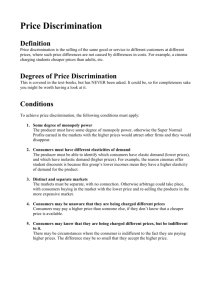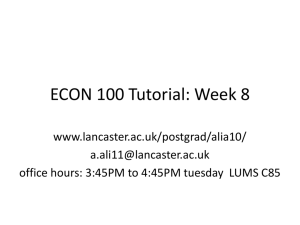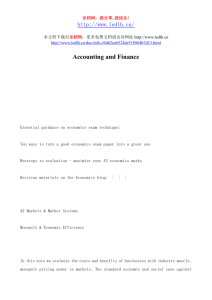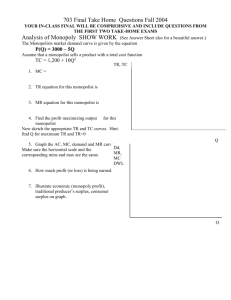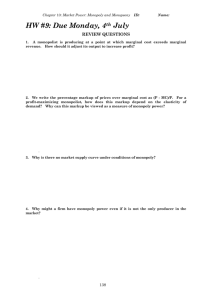Perfect Competition
advertisement
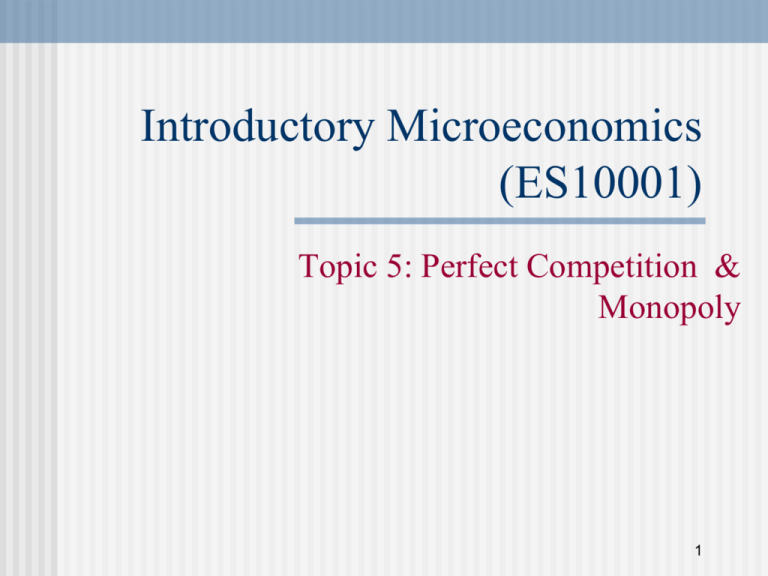
Introductory Microeconomics (ES10001) Topic 5: Perfect Competition & Monopoly 1 1. Introduction MR = MC rule requires knowledge of market structure One of the major influences on MR, and thus on its supply decision, is the degree of competitiveness the firm faces in the market. That is, the number of actual and potential competitors 2 1. Introduction This makes sense! If firm is the only player in the market, then we would expect it to behave differently than if it were one of (very) many In what follows we will examine the causes and effects of market structure 3 2. Taxonomy of Competition Microeconomics has tended to categorise the degree of competition a particular firm faces into three very precise and distinct categories: A lot; A bit; None! 4 Figure 1: Taxonomy of Competition Perfect Competition More Competition Monopoly Imperfect Competition Less Competition Monopolistic Competition Oligopoly Collusive (i.e. Cartel) Non-Collusive 5 3. Perfect Competition Market structure where competitive forces are at their greatest Definition: A Perfectly Competitive (PC) market is one in which both buyers and sellers believe that their own buying or selling decisions have no effect on the market price Sometimes referred to as an ‘atomistic’ market 6 3. Perfect Competition Formal Characteristics 1. (Very) Large number of buyers and sellers; 2. Homogenous product; 3. Free entry and exit (in long-run); 4. Perfect knowledge. Implication: All firms face same, perfectly elastic, demand curve 7 Figure 2: Perfectly Elastic Demand p S0 E0 d0 p0 D0 0 Q0 Industry Q q Representative Firm 8 3. Perfect Competition Why would firm not raise or lower price above or below p0? If p > p0, then it would sell nothing because consumers have perfect knowledge and good is homogenous Conversely, no point in setting p < p0 since it can sell as much as it wishes at p0 9 3. Perfect Competition Firm’s demand curve is also its AR and MR curve Recall: AR = TR / q MR = ΔTR / Δq Since demand is perfectly elastic, AR = MR = p 10 Figure 3: Demand = AR = MR p 5 0 E0 E1 d 1 2 q 11 Figure 3: Demand = AR = MR p E0 5 E1 d TR1=5 AR1=5/1=5 0 1 2 q 12 Figure 3: Demand = AR = MR p 5 E0 E1 d TR2 =2*5=10 AR2=5/1=5 MR2 = TR2–TR1= 5 0 1 2 q 13 Figure 3: Demand = AR = MR p 5 0 E0 E1 d = AR = MR 1 2 q 14 3. Perfect Competition Consider short-run profit maximising rule First, we know that to maximise profit we need to set SMR = SMC But ... 15 Figure 4: Optimal Output p SMC p0 0 E0 E1 q0 q1 d = AR = MR q 16 3. Perfect Competition Consider short-run profit maximising rule First, we know that to maximise profit we need to set SMR = SMC But, SMC must also be rising … … otherwise, profit (loss) is minimised (maximised) 17 Figure 4: Optimal Output p SMC π min p0 0 E0 π max E1 q0 q1 d = AR = MR q 18 3. Perfect Competition Thus, short-run profit maximising rule (1) MR = SMC (2) SMC is rising But, it could always be in firm’s interest to produce nothing! Is there a ‘shut-down’ price? 19 Figure 5: Demand = AR = MR p π >0 SMC Eo p0 AR =MR SAC PROFIT SAVC SAC0 0 q0 q 20 Figure 6: Demand = AR = MR p π =0 SMC SAC SAVC p1 0 E1 AR = MR q1 q 21 Figure 7: Demand = AR = MR p - TFC < π < 0 SMC SAC E2 SAVC SAC2 p2 0 LOSS < - TFC MR q2 q 22 3. Perfect Competition Proof: π(q) = TR – (TVC + TFC) = (TR – TVC) – TFC Thus: p > AVC => p*q > AVC*q => TR > TVC => (TR – TVC) > 0 Thus: π(q) > π (0) = -TFC 23 Figure 8: Demand = AR = MR p π = - TFC < 0 SMC SAC E3 SAVC SAC3 p3 0 LOSS = TFC AR = MR q3 q 24 Figure 9: Demand = AR = MR p π < - TFC < 0 SMC SAC SAVC SAC4 LOSS > TFC p4 AR = MR E4 0 q4 q 25 3. Perfect Competition Thus, short-run profit maximising rule MR = SMC SMC is rising p > SAVC Supply curve of the firm is that part of its SMC curve above minimum SAVC 26 Figure 8: Demand = AR = MR p π = - TFC < 0 SMC SAC E3 SAVC SAC3 p3 0 LOSS = TFC AR = MR q3 q 27 Figure 8: p SMC SAVC p3 0 AR = MR q 28 Figure 8: p SR Supply Min AVC 0 q 29 3. Perfect Competition Note, short-run ‘shutdown’ price = p3 = SAVC(q3) π(p3) = p3*q3 – SAC(q3)*q3 = [SAVC(q3) – SAC(q3)]*q3 = -AFC(q3)*q3 = -TFC 30 3. Perfect Competition Thus, short-run supply curve of firm is that part of its SMC above minimum AVC Similarly, long-run supply curve is that part of LMC above minimum LAC i.e. long-run ‘shutdown’ option is to leave the industry 31 Figure 10: Long-Run Shut-Down p LMC p0 0 LAC AR = MR q0 q 32 3. Perfect Competition Compare SR and LR supply curves SR supply curve of firm is that part of its SMC above minimum AVC; similarly, long-run supply curve is that part of LMC above minimum LAC i.e. LR ‘shutdown’ option is to leave the industry Note that SR supply curve lays below LR supply curve (recall ‘Envelope’) and is steeper 33 Figure 11: Long-Run & Short-Run Supply p SSR Min LAC SLR p1 p0 Min AVC 0 q 34 3. Perfect Competition SSR lays below SLR because LAC is envelope of SAC’s and SAVC’s lay below SAC since SAC includes AFC SSR is steeper than SLR because it will always be less costly for firm to increase output when it can alter all inputs (i.e. K an L) appropriately (i.e. when it is in LR) Now, consider MR = MC condition 35 3. Perfect Competition TR0 = p0q0 TR1 = p1q1 Thus: ΔTR =TR1 - TR0 = p1q1 - p0q0 = p1q1 - p0q0 + (p1q0 - p1q0) = p1q1 - p1q0 + p1q0 - p0q0 = p1(q1 - q0) + (p1 - p0)q0 36 3. Perfect Competition ΔTR = p1(q1 - q0) + (p1 - p0)q0 = p1Δq + Δpq0 Thus: DTR Dp º MR = p1 + × q0 Dq Dq Consider ‘small’ changes in (p, q) such that p1 ≈ p0, q1 ≈ q0 , and so (p0, p1) ≈ p and (q0, q1) ≈ q 37 3. Perfect Competition Thus: Dp Dp MR = p1 + × q0 = p + ×q Dq Dq Þ æ Dp q ö MR = p ç 1+ × ÷ Dq p ø è Dq p × >0 Now, recall: E = Dp q 38 3. Perfect Competition Thus: æ Dp q ö æ 1ö MR = p ç 1+ × ÷ = p ç 1- ÷ è Dq p ø è Eø Under perfect competition, E => ∞ such that MR => p Also, since MR = MC in equilibrium, then: æ 1ö MC = p ç 1- ÷ è Eø 39 3. Perfect Competition Thus: æ 1ö p MC = p ç 1- ÷ = p E è Eø Þ p p - MC = E Þ p - MC 1 = p E 40 3. Perfect Competition Lerner (1934) ‘Index of Monopoly Power’ p - MC 1 = p E Note that under perfect competition, E => ∞ such that p => MC Firms can only ‘mark-up’ p over MC iff E < ∞ 41 Figure 12: Elasticity of Demand and Slope of (Inverse) Demand Curve p Dq p E=× >0 Dp q E0 dc Dp Dqa Dqb 0 da db q 42 3. Perfect Competition Industry Supply SR industry supply curve (when factor prices are given) is the horizontal summation of each firm’s SMC curve above minimum AVC Similarly, LR industry supply curve (when factor prices are given) is horizontal summation of each firm’s LMC curve above minimum LAC 43 Figure 13: SR Industry Supply p p Ssra = SMC Q0 = 2q0 p Q1 = 2q1 a Q2 = 2q2 Ssrb = SMC b SSR = å SMC p2 p1 p0 0 q0 q1 q2 Firm A qa 0 q0 q1 q2 Firm B qb 0 Q0 Q1 Industry Q2 Q 44 3. Perfect Competition Consider effect of an exogenous increase in industry demand for the good Increase in demand will increase each existing firm’s profit Existing firms increase SR supply by moving up their SMC curves 45 Figure 14a: SR Industry Supply p p S SMC SR 0 SAC e0 E0 p0 d0 D0 0 Q0 Industry Q q0 Representative Firm q 46 Figure 14b: SR Industry Supply p p S SMC SR 0 SAC e1 E1 e0 E0 p0 d1 d0 D1 D0 0 Q0 Q1 Industry Q q0 q1 Representative Firm q 47 3. Perfect Competition But, the existence of super-normal profits will attract other firms into the industry This will shift out industry (SR) supply curve and lead to a fall in the (perfectly elastic) demand facing individuals firms Industry supply is higher because of entry of new firms; each firm produces same amount in new equilibrium (E2) as original firms produced in 48 original equilibrium (E0) Figure 14c: SR Industry Supply p p S SR 0 SMC S1SR SAC e1 E1 E0 p0 e2 = e0 E2 d1 d0 D1 D0 0 Q0 Q1 Q2 Industry Q q0 q1 Representative Firm q 49 3. Perfect Competition LR supply curve of industry is horizontal / perfectly elastic LR supply price of industry is equal to minimum LAC of constituent firms Thus, demand only determines quantity; price is supply (i.e. cost) determined) 50 Figure 15: LR Industry Supply p P LMC LAC p* e* E* SLR D 0 q* Representative Firm q 0 Q* Industry Q 51 3. Perfect Competition LR supply curve of industry is upward sloping in two situations: 1. Factor prices increase with usage 2. Heterogeneous firms Consider each in turn 52 3. Perfect Competition Consider first the SR response of a representative firm and the industry to an increase in demand If factor prices increase with usage, then increase in demand induces each firm to increase output along its SMC curve But, increase in industry supply of output increases demand for / price of the variable input 53 3. Perfect Competition Increase in price of variable input shifts up vertically each firm’s SMC curve The expansion of output by each firm can thus be interpreted as a combination of a ‘movement along’ and a ‘shift of’ its SMC curve Similarly, the expansion of output by the industry combination of a ‘movement along’ / ‘shift of’ the aggregation of constituent firms’ SMC curves 54 Figure 16: SR Industry Supply Factor prices increase with usage p p ∑SSR D1 SSR ∑SMC1 E1 e1 p1 SMC0 D0 SMC1 p0 0 ∑SMC0 E0 e0 q0 q1 Representative Firm q Q0 Q1 Industry Q 55 3. Perfect Competition In LR, free entry / exit implies each firm produces at minimum LAC If firms are equally efficient, then firms have same minimum LAC and industry supply is perfectly elastic Intuitively, whatever happens to demand, SR supply, and thus price, competitive forces ensure a normal-profit LR equilibrium such that LR supply 56 is perfectly elastic at minimum LAC 3. Perfect Competition But this presumes factor prices are fixed What if factor prices increase with their usage? In this case, then LR expansion of output by the industry will increase the price of all factors such that each constituent firm’s LAC and LMC will shift-up 57 3. Perfect Competition Thus, LR industry response to increase in demand when factor prices increase with their usage is a combination of: (i) a ‘movement along’ a perfectly elastic LR supply curve (i.e. one determined by minimum LAC of equally efficient constituent firms, but where factor prices are held constant); (ii) a ‘shift-up’ of such a curve (i.e. where factor prices are allowed to increase) 58 Figure 17: LR Industry Supply p Factor prices increase with usage S LR E1 * 1 p * 0 p S1LR E0 S0LR D1 D0 0 * 0 Q * 1 Q Q 59 3. Perfect Competition Consider also ‘heterogeneous firms’ i.e. inter-firm differences in efficiency The earlier firms enter into an industry, the lower their cost curves; subsequent firms are increasingly less efficient 60 3. Perfect Competition At any particular LR equilibrium price, p*, the least efficient (i.e. ‘marginal’) firm is that firm which can make just normal profit at p* The more efficient (i.e. ‘intra-marginal’) firms make positive profits at p* and, thus, produce in the region of DRS 61 Figure 18: LR Industry Supply p Heterogeneous Firms p p LMC2 LMC1 LAC1 p* SLR LAC2 e1 E* e2 LAC1 D 0 q1 q (Intra-Marginal) Firm 1 0 q2 (Marginal) Firm 2 q Q* 0 Q Industry 62 4. Monopoly Consider now the other extreme market environment Monopoly; single seller The monopolist is the industry; no distinction between firm and industry; less need to distinguish SR and LR since entry / exit is less of an issue Consider monopolist's AR and MR curves 63 4. Monopoly As with PC firm, demand curve is also the AR curve But since AR curve is downward sloping, MR curve lays below AR curve Intuitively, to sell more Q, monopolist has to cut p on all units of Q 64 Figure 19a: AR and MR p p1 TR1 = p1 TR2 = 2p2 A MR2 = 2p2 - p1 = p2 - (p1-p2) < p2 B p2 C MR2 D = AR MR 0 1 2 Q 65 Figure 19b: AR and MR p p1 TR1 = p1 TR2 = 2p2 A MR2 = 2p2 - p1 = p2 - (p1-p2) < p2 B p2 p2 C MR2 D = AR MR 0 1 2 Q 66 Figure 19c: AR and MR p TR1 = p1 TR2 = 2p2 A p1 (p1-p2) MR2 = 2p2 - p1 = p2 - (p1-p2) < p2 B p2 p2 C MR2 D = AR MR 0 1 2 Q 67 4. Monopoly We will assume that the monopolist, like PC firms and industries, faces increasing and then decreasing returns to both factors and scale; i.e. ‘U-Shaped’ SAC / LAC N.B. Monopoly that faces IRS always is termed a ‘Natural Monopoly’ Monopolist's profit can be supernormal (most likely), normal or negative 68 Figure 20a: Monopolist LR Equilibrium p π>0 LMC p0 LAC Profit LAC0 D = AR MR 0 Q0 Q 69 Figure 20b: Monopolist LR Equilibrium p π<0 LMC LAC LAC0 p0 Loss MR 0 Q0 D = AR Q 70 Figure 20c: Monopolist LR Equilibrium p π=0 LMC LAC p0 = LAC0 MR 0 Q0 D = AR Q 71 4. Monopoly Consider efficiency Allocative Efficiency (AE) p = MC Productive Efficiency (PE) IRS are exhausted such that LAC is minimised 72 4. Monopoly (Non-Discriminating) monopolist is never AE and (extremely) unlikely to be PE PE would require MR curve to cross MC at minimum AC It can happen, but infinitely small chance! 73 Figure 21: Monopolist LR Equilibrium p Productive efficiency is possible, but very unlikely! LMC pmes LAC LACmes D = AR MR 0 Qmes Q 74 4. Monopoly Allocative Efficiency requires marginal (social) benefit (MSB) to equal marginal (social) cost (MSC) Define: MSC = MPC + MEC MSB = MPB + MEB i.e. marginal social benefit (cost) equals marginal private benefit (cost) plus marginal external benefit (costs) 75 4. Monopoly Private benefits (costs) are those enjoyed (incurred) by agent producing or consuming) the good External benefits (costs) are the non-price effects on the production or consumption of other members of society Assume (for now!) that MEC = MEB = 0 such that allocative efficiency requires MPC = MPB 76 4. Monopoly Now: MPC = LMC of monopolist MPB = price consumers willing to pay for good Thus, the MPB can be derived from the monopolist's Demand = AR curve Recall, the (inverse) demand curve sets out consumer's reservation price vis. the maximum price the consumer is willing to pay 77 Figure 22: D = MPB p p1 A B p2 C p3 D = MPB 0 Q1 Q2 Q3 Q 78 4. Monopoly It is apparent that the monopolist produces less output than the socially optimal (allocatively efficient) level Monopolist maximises profit by setting MR = MC Allocative efficiency is achieved when p = MC Since p > MR, it must be the case that monopolist output is less than socially optimal 79 Figure 23: Monopolist LR Equilibrium p DWL = ABC Privately Optimal LMC = MPC Socially Optimal p0 A B LAC0 LAC D = AR = MPB C MR 0 Q0 Q1 Q 80 4. Monopoly Consider the (‘overnight’) monopolisation of a PC industry The constituent firms of the industry become manufacturing plants for the monopolist Assume that the SLR = ∑LMC of the PC industry becomes the monopolist’s LMC curve (N.B. heterogeneous firms thus SLR is upward sloping) 81 4. Monopoly Define social welfare (SW) as sum of consumer surplus (CS) and producer surplus (PS) SW = PS + CS NB: No concern with equity! 1+ 99 = 100 = 99 + 1 Define CS as excess of what consumers are willing to pay over what they actually pay; PS as excess of what producers actually receive over what they are willing to receive 82 Figure 22a: Monopoly and PC p A SLR CS pc C Perfect Competition B CS = ABC PS = BCD SW = ABD PS D 0 D = AR Qc Q 83 Figure 22a: Monopoly and DWL p A LMC G pm E Monopoly pc C B CS = AEG PS = GEFD SW = AEFD DWL = EBF F D 0 MR Qm Qc D = AR Q 84 Figure 22a: Monopoly and DWL p A LMC G pm E Monopoly pc C H B ΔCS = -GEHC - EBH ΔPS = +GEHC - BHF ΔSW = -EBH - BHF F D 0 MR Qm Qc D = AR Q 85 4. Monopoly But this is a static analysis - i.e. the instantaneous effects of monopolisation; what happens to cost over time, i.e. dynamic effects? Two scenarios: (i) Liebenstein ‘X-Inefficency’ (pessimistic) (ii) Schumpeter ‘R&D’ (optimistic) Balance of argument - empirical issue 86 Figure 22a: Monopoly and DWL p A Liebenstein B pm LMC E pc C B Schumpeter F D 0 MR Qm Qc D = AR Q 87 4. Monopoly To summarise; monopolies would appear to be harmful to society in sense that they lead to DWL (i.e. consumers lose more than producers gain) Perhaps some benefits over time (R&D), but that is an empirical issue There is an argument, however, that if we are to have monopolies, then we should make them as powerful as possible! 88 4. Monopoly Price Discrimination (PD) Selling different units of the same good at different prices Two basic approaches to PD: Charging different prices to different consumers for same units of the good; Charging same consumers different prices for different units of the good 89 4. Monopoly Three main types of PD: 1. First-Degree (Perfect); 2. Second-Degree; 3. Third-Degree Consider each in turn 90 4. Monopoly First-Degree (Perfect) Price Discrimination Monopolist charges each consumer maximum price willing to pay for each unit of the good; thus demand curve is also MR curve, since only reduce p on additional units of Q Monopolist produces socially optimal Q (i.e. p = MC) and is thus allocatively efficient (DWL = 0) but completely inequitable (CS = 0) 91 Figure 23: First Degree (Perfect) Price Discrimination p A p1 p2 A' LMC A'' Perfect PD PS p* B CS = 0 PS = ABC SW = ABC DWL = 0 C 0 D = MR 1 2 Q* Q 92 4. Monopoly First-Degree (Perfect) Price Discrimination Monopolist charges each consumer maximum price willing to pay for each unit of the good; thus demand curve is also MR curve, since only reduce p on additional units of Q Monopolist produces socially optimal Q (i.e. p = MC) and is thus allocatively efficient (DWL = 0) but completely inequitable (CS = 0) 93 Figure 23: First Degree (Perfect) Price Discrimination p A p1 p2 p3 p* A1 LMC A2 A3 Perfect Price Discrimination PS F B Price = ABCD; Quantity = Q* CS = 0 PS = ABE SW = ABE DWL = 0 E D = MR D 0 C 1 2 3 Q* Q 94 Figure 23: First Degree (Perfect) Price Discrimination p A LMC Perfect Price Discrimination PS B Price = ABCD; Quantity = Q* CS = 0 PS = ABE SW = ABE DWL = 0 E 0 D = MR 1 2 3 Q* Q 95 4. Monopoly Second-Degree Price Discrimination Monopolist knows there are different ‘types’ of consumers with different WTP (i.e. utility from consuming good) but cannot identify them individually CSi(x) = ui(x) – p(x) uH(x) > uL(x) – i.e. H values good x more than L i = H, L 96 Figure 23: Second-Degree Price Discrimination p Consider two ‘packages’ vis: (PH, xH) DH (PL, xL) Assume production is costless DL B A 0 C xL D xH x 97 Figure 23: Second-Degree Price Discrimination p Ideally, monopolist would like to extract all CS. e.g. DH PH = A + B + C PL = A DL B A 0 C xL D xH x 98 Figure 23: Second-Degree Price Discrimination p Such pricing will ensure zero CS vis: DH PH = A + B + C PL = A DL => B CSH(xH) = 0 = CSL(xL) A 0 C xL D xH x 99 Figure 23: Second-Degree Price Discrimination p But H prefers (PL, xL) to (PH, xH): PH = A + B + C DH PL = A => DL CSL(xH) = - (B + C + D) < 0 B CSH(xL) = B > 0 A 0 C xL D xH x 100 Figure 23: Second-Degree Price Discrimination p Thus, monopolist must remove B from (PH, xH): PH = A + C DH PL = A => CSH(xH) = B = CSH(xL) DL CSL(xL) = 0 B CSL(xH) = - (C + D) < 0 A 0 C xL D xH x 101 Figure 23: Second-Degree Price Discrimination p Optimal packages? Consider cut in xL to xLL DH => PH(xH) = A1 + A2 + B2 + C PL(xLL) = A1 DL 0 B1 B2 A1 A2 xLL C xL D xH x 102 Figure 23: Second-Degree Price Discrimination p (xLL, xH) is still incentive compatible => CSH(xH) = B1 = CSH(xL) DH CSL(xLL) = 0 CSL(xH) = - (B2+ C + D) < 0 DL 0 B1 B2 A1 A2 xLL C xL D xH x 103 Figure 23: Second-Degree Price Discrimination p Effect on profit? => π(xH, xL) = (A1 + A2) + (A1 + A2 + C) DH π(xH, xLL) = A1 + (A1 + A2 + B2 + C) => DL 0 Δπ = π(xH, xLL) - π(xH, xL) = - A2 + B2 B1 B2 A1 A2 xLL C xL D xH x 104 Figure 23: Second-Degree Price Discrimination p Optimal package is found by reducing xL until MC (i.e. in A2) equals MR (i.e. in B2) DH PH(xH*) = A1 + A2 + B2 + C a DL A1 0 PL(xL*) = A1 B1 where b B2 c A2 xL* a-b = b-c C D xH* x 105 4. Monopoly Third-Degree Price Discrimination Monopolist sells good at different prices to different groups of consumers Monopolist must be able to identify distinct markets Geographical, age, gender, race … 106 4. Monopoly Assume monopolist sells identical good to two markets (A and B) Assume costs of producing and supplying good to either market are identical E.g. Cinema selling seats in Bath to students and lecturers who have distinct reservations prices and elasticities of demand from each other 107 Figure 24a: Third-Degree Price Discrimination p p p LMC ~ p ARB AR MR MRB ARA MRA 0 QA QB 0 QA 0 Market A Market B Lecturers Students Q Q = QA Market A + B 108 4. Monopoly Assume first that price-discrimination is illegal The cinema will maximise profit by setting (aggregate) MR = LMC Thus, sells Q = QA + QB seats in total at a common price of p = p QA to lecturers and QB to students 109 Figure 24b: Third-Degree Price Discrimination p p p LMC p ARA ARB AR MRB MR MRA 0 QA QA 0 QB 0 QB Market A Market B Lecturers Students Q Q = QA + QB Market A + B 110 4. Monopoly Assume now that price discrimination is legal Setting a common price implies that MRA ≠ MRB Thus, the monopolist can increase its revenue (and since production costs are independent of the market supplied, its profit) by transferring Q from the low MR market to the high MR market 111 Figure 24c: Third-Degree Price Discrimination p p p LMC p MRB MRA ARB AR MR MRB ARA MRA 0 QA QA 0 QB 0 QB Market A Market B Lecturers Students Q Q = QA + QB Market A + B 112 4. Monopoly As Q is withdrawn from the low MR market, p and MR in that market rise; And vice versa, as Q is transferred to the high MR market, p and MR in that market fall; profit is maximised when MRA = MRB 113 p p p LMC pA p pB MRB AR ARB MR MRA MRB ARB MR MRA 0 QA Q A Market A QA 0 QB QB Market B QB 0 Q Q = QA + QB Market A + B 114 4. Monopoly Intuitively, lecturers have relatively inelastic demand, thus it is optimal to raise the price they face, since relatively little demand is lost Conversely, students have relatively elastic demand, thus it is optimal to lower the price they face since demand increases substantially 115 4. Monopoly Recall: æ 1ö MRi = pi ç 1- ÷ è Ei ø Thus: æ æ 1 ö 1 ö MRA = p A ç 1= MC = pB ç 1= MRB ÷ ÷ è EA ø è EB ø 116 4. Monopoly Recall: æ 1ö MRi = pi ç1 - ÷ è Ei ø Thus: If MRA = MRB, but EA < EB, then pA > pB 117 4. Monopoly For all this to work: 1. Group making up sub-markets must have distinct elasticities of demand; 2. Third-degree price discrimination must be legal; 3. There must be no arbitrage between the groups (i.e. usually used in service industries) 118 p p ARb = Db ARa = Da A p B E G K pa I L p J M pb C D 0 F H qb N qb Q 119 Area No Price Discrimination (1) Price Discrimination (2) Change (2) – (1) CSb +A +A+B+E+G +B+E+G Rb +B+E+C+D+F +C+D+F+H -B-E+H CSa +K+I+L +K -I-L Ra +G+H+J+M+N +L+M+N -G-H-J+L SW +A+B+C+D+E+F+ +A+B+C+D+E+F+ G+H+I+J+K+L+M+ G+H+K+L+M+N N -I-J 120 Figure 23: Natural Monopoly p pm LAC LAC MR 0 Qm D LMC Q 121 Figure 23: Natural Monopoly p LAC p = LMC p <0 LAC D MR 0 Q* LMC Q 122 4. Monopoly Finally … Note that the monopolist does not have a supply curve No one-to-one mapping between price and quantity supplied 123 Figure 23: Monopolist does not have a supply curve p LMC p0 E1 E0 AR1 AR0 MR0 0 Q0 Q1 MR1 Q 124
